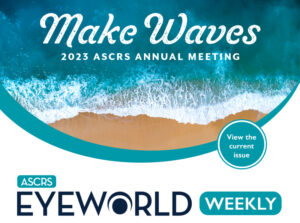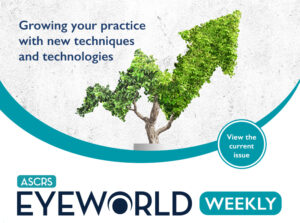
- FDA approves device to treat MGD
- Standalone MIGS device trial begins
- Topline results for novel dry eye candidate
- Orphan drug designation granted for topical LHON treatment
- Positive safety results in Phase 1/2a trial for investigational treatment of wet AMD
- Updates on two investigational RNA therapies
- ASCRS news and events
January 7, 2022 • Volume 28, Number 1
FDA approves device to treat MGD
Sight Sciences has received FDA 510(k) clearance of its TearCare System for treatment of MGD. According to the company’s press release, TearCare is indicated for evaporative dry eye disease due to MGD. TearCare, in conjunction with manual meibomian gland expression, uses localized heat therapy to soften thickened meibum to clear glands. FDA clearance, the company reported, was based on clinical trials that found, among other things, use of TearCare resulted in significant improvements in mean tear film breakup time and meibomian gland secretion scores. It also significantly reduced mean eye dryness scores.
Standalone MIGS device trial begins
Ivantis has begun a pivotal clinical trial for standalone application of its Hydrus Microstent (without concurrent cataract surgery as indicated in its current FDA approval). According to the company’s press release, the first patient has been enrolled in the FRONTIER trial, which will evaluate the use of Hydrus as a standalone MIGS in patients with mild to moderate open-angle glaucoma who have already had cataract surgery. The company noted that outside the U.S., Hydrus is already used in standalone procedures.
Topline results for novel dry eye candidate
Stuart Therapeutics announced topline results for its first-in-human, Phase 2 clinical trial of its novel, investigational dry eye treatment, ST-100. According to the company’s press release, ST-100 is a topical eye drop designed to restore structural and cell signaling capabilities of otherwise damaged helical collagen. Previous studies suggested that it repaired nerve pathways damaged by dry eye. The Phase 2 trial was multicenter, randomized, controlled, and double masked, enrolling 160 patients. Participants were dosed with 20 mg/ml ST-100, 50 mg/ml ST-100, or placebo. The 50 mg/ml dose achieved its primary endpoint—a statistically significant difference between percentage of patients achieving a 10-mm increase or more in Schirmer’s tear test scores at day 28. Other significant results were obtained, too, including an improvement in ocular discomfort at day 14. The drug was well tolerated and there were no serious drug-related adverse events.
Orphan drug designation granted for topical LHON treatment
Mitotech announced that it received an orphan drug designation from the FDA for Visomitin, a topical cardiolipin peroxidation inhibitor, for the treatment of Leber hereditary optic neuropathy (LHON). According to the company’s press release, a Phase 2 study of this drug for LHON is planned this year. In a 3-year, open label Phase 2a study conducted outside of the U.S. in patients with LHON, Visomitin showed improvement in visual acuity over several years.
Positive safety results in Phase 1/2a trial for investigational treatment of wet AMD
Clearside Biomedical announced positive safety results from its Phase 1/2a OASIS trial investigating CLS-AX (axitinib injectable suspension) administered via suprachoroidal injection with the company’s SCS Microinjector as a treatment for wet AMD. According to the company’s press release, the 0.1 mg dose was well tolerated with no serious adverse events or adverse events related to IOP, inflammation, or vasculitis. The company also noted that there was no dispersion of the drug into the vitreous. Clearside Biomedical will advance research in a third cohort that will receive a 0.5 mg dose of CLS-AX, according to the press release.
Updates on two investigational RNA therapies
ProQR Therapeutics recently released updates on two trials for its RNA therapies for genetic eye diseases. One announcement was that the first patients were dosed in the Phase 2/3 Sirius and Celeste clinical trials investigating QR-421a for patients with USH2A-mediated retinitis pigmentosa and Usher syndrome. QR-421a is described by the company as a first-in-class RNA therapy designed to address mutations on exon 13 of the USH2A gene in order to restore functional usherin protein with an exon skipping approach. The company also announced that the last patient in the Illuminate trial completed their final visit at month 12. The Illuminate Phase 2/3 trial is investigating sepofarsen for CEP290-mediated Leber congenital amaurosis 10. Sepofarsen is described by the company as a first-in-class investigational RNA therapy that is designed to enable normal splicing of mRNA leading to production of a functional CEP290 protein. Both investigational RNA therapies have orphan drug designations in the U.S. and Europe.
ASCRS news and events
- 2022 ASCRS Annual Meeting: Tier 1 pricing for registration for the ASCRS Annual Meeting in Washington, D.C., April 22–26, 2022, is open through January 12. There is also an open call for complicated case video submissions.
- ASCRS Winter Symposium: Registration is open for the Winter Symposium in Park City, Utah, February 10–12. The meeting focuses on the innovative techniques and controversies in anterior segment ophthalmology.
- Beyond 20/20: Beyond 20/20: An ASCRS Series in Modern Refractive Surgery and Presbyopia Therapy is a new, four-part educational program sponsored by the Refractive Clinical Committee that features CME and non-CME components. Learn more about the program and register here.
Research highlights
- A retrospective, non-comparative, single-center interventional study sought to evaluate the outcomes of sutureless, glueless intrascleral fixation of 3-piece IOLs in the ciliary sulcus in a large cohort of patients. According to the research published in the journal Eye, 250 patients who were aphakic due to various etiologies were enrolled. At least 3 months follow-up postop was required for inclusion in the study. Mean BCVA improved postop from 0.74±0.6 logMAR (20/110) to 0.48±0.36 logMAR (20/60). Postop complications within the first 2 weeks were hypotony (4%), ocular hypertension (15.2%), and vitreous hemorrhage (20%). Complications that occurred later included retinal detachment (5.6%), cystoid macular edema (9.6%), scleral erosion (0.4%), haptic extrusion into the subconjunctival space (1.2%), and IOL subluxation or dislocation (2%). The authors concluded that sutureless, glueless scleral fixation is cost effective and well tolerated and provides good visual acuity.
- A report published in the journal Cornea described four cases of acute corneal transplant rejection occurring after COVID-19 vaccination. According to the paper, one patient had DMEK 6 months prior and experienced endothelial graft rejection 3 weeks after the first dose of the mRNA-1273 vaccine. Another case had PK 3 years prior and experienced endothelial rejection 9 days after the second vaccine dose. Case 3 had DSAEK and experienced graft rejection 2 weeks after the second vaccine dose, and case 4 presented with PK graft rejection also 2 weeks post-second vaccine dose. The authors reported that topical corticosteroids were used in all four cases. Case 1 improved over 5 weeks post-rejection diagnosis, and case 2 saw complete resolution of corneal stromal edema and rejection line after 6 weeks. Cases 3 and 4 experienced initial improvement with the steroid treatment. The authors advocated for further study to better understand the mechanism that is possibly causing corneal graft rejection after COVID-19 vaccination.
Product news
- ImprimisRx will now sell, market, and distribute the following medications after obtaining exclusive commercialization rights from Novartis: IOPIDINE 1% (apraclonidine hydrochloride), IOPIDINE 0.5%, MAXITROL (neomycin and polymyxin B sulfate and dexamethasone) 3.5 mg/10,000 units/0.1%, and MOXZEMA 0.5% (moxifloxacin hydrochloride).
This issue of EyeWorld Weekly was edited by Stacy Jablonski and Liz Hillman.
EyeWorld Weekly (ISSN 1089-0319), a digital publication of the American Society of Cataract and Refractive Surgery (ASCRS), is published every Friday, distributed by email, and posted live on Friday.
Medical Editors: Eric Donnenfeld, MD, Chief Medical Editor; Rosa Braga-Mele, MD, Cataract Editor; Clara Chan, MD, Cornea Editor; Nathan Radcliffe, MD, Glaucoma Editor; and Vance Thompson, MD, Refractive Editor
For sponsorship opportunities or membership information, contact: ASCRS • 12587 Fair Lakes Circle • Suite 348 • Fairfax, VA 22033 • Phone: 703-591-2220 • Fax: 703-591-0614 • Email: ascrs@ascrs.org
Mention of products or services in EyeWorld Weekly does not constitute an endorsement by ASCRS.
Click here to view our Legal Notice.
Copyright 2022, EyeWorld News Service, a division of ASCRSMedia. All rights reserved.



